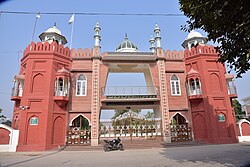Malerkotla district | |
|---|---|
 Eidgah in Malerkotla | |
 Location in Punjab | |
| Coordinates: 30°32′N75°53′E / 30.53°N 75.88°E | |
| Country | |
| State | |
| Division | Patiala |
| Established | 02 June 2021 |
| Headquarters | Malerkotla |
| Government | |
| • Deputy Commissioner | Sh.Sanyam Agarwal, IAS |
| • Senior Superintendent of Police | Smt. Alka Meena IPS |
| Area | |
• Total | 684 km2 (264 sq mi) |
| Population (2011) | |
• Total | 429,754 |
| • Rank | 23rd |
| • Density | 629/km2 (1,630/sq mi) |
| Languages | |
| • Official | Punjabi |
| Time zone | UTC+5:30 (IST) |
| PIN | 148XXX |
| Vehicle registration | PB-28(for Malerkotla) PB-82(for Ahmedgarh) PB-92(for Amargarh) |
| Headquarters | Malerkotla |
| Sex ratio | 896 ♂/♀ |
| Literacy | 76.28% |
| Lok Sabha constituency | Sangrur Fatehgarh Sahib |
| Punjab Legislative Assembly constituency | 2 •Amargarh |
| Precipitation | 450 millimetres (18 in) |
| Avg. summer temperature | 48 °C (118 °F) |
| Avg. winter temperature | 7 °C (45 °F) |
| Website | malerkotla |
Malerkotla district is a district in Punjab state of India. It was formed after the bifurcation of Sangrur district. Malerkotla district was carved out of Sangrur and became the 23rd district of Punjab on 02 June, 2021, on the occasion of Eid. [1] District Malerkotla is divided into three Tahsils: Malerkotla, Amargarh and Ahmedgarh. [2]




